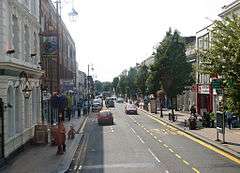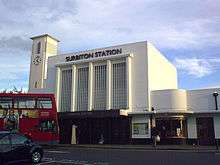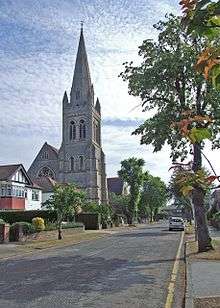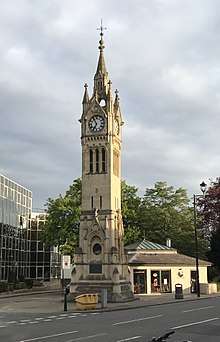Surbiton
Surbiton is a suburban neighbourhood of south-west London, within the Royal Borough of Kingston upon Thames (RBK). It is situated next to the River Thames, 11 miles (18 km) southwest of Charing Cross. Formerly part of the ancient parish of Kingston upon Thames in the county of Surrey, it has been part of Greater London since 1965. Surbiton comprises four of the RBK's wards: Alexandra, Berrylands, St. Mark's, and Surbiton Hill.[1]
| Surbiton | |
|---|---|
 Victoria Road, Surbiton's high street | |
 Surbiton Location within Greater London | |
| Area | 7.18 km2 (2.77 sq mi) |
| Population | 45,132 |
| • Density | 6,286/km2 (16,280/sq mi) |
| OS grid reference | TQ180673 |
| London borough | |
| Ceremonial county | Greater London |
| Region | |
| Country | England |
| Sovereign state | United Kingdom |
| Post town | SURBITON |
| Postcode district | KT5, KT6 |
| Dialling code | 020 |
| Police | Metropolitan |
| Fire | London |
| Ambulance | London |
| UK Parliament | |
| London Assembly | |
Founded originally as Kingston-upon-Railway during the Industrial Revolution, Surbiton possesses a mixture of grand 19th-century townhouses, Art Deco courts, and more recent residential blocks blending in with semi-detached 20th-century housing estates. With a population of 45,132 in 2016, it accounts for approximately 25% of the total population of the Royal Borough of Kingston upon Thames.[2] Surbiton extends over an area of 7.18 km2 (2.77 sq mi).[3]
Etymology
Though Surbiton only received its current name in 1869, the name is attested as Suberton in 1179, Surbeton in 1263, Surpeton in 1486, and finally Surbiton 1597.[4] Sūth Bere-tūn means "southern grange" or "outlying farm" in Old English, as opposed to nearby Norbiton; both Norbiton and Surbiton were possessions of the royal manor of Kingston.[4]
History

The present-day town came into existence after a plan to build a London-Southampton railway line through nearby Kingston was rejected by Kingston Council, who feared that it would be detrimental to the coaching trade. This resulted in the line being routed further south, through a cutting in the hill south of Surbiton. Surbiton railway station opened in 1838, and was originally named Kingston-upon-Railway.[5] It was only renamed Surbiton to distinguish it from the new Kingston railway station on the Shepperton branch line, which opened on 1 January 1869. The present station has an art deco façade.
As a result, Kingston is now on a branch line, whereas passengers from Surbiton (smaller in comparison) can reach London Waterloo in as little as 17 minutes[6] on a fast direct service; as well as places further afield, including Portsmouth and Southampton.
Surbiton was once home to Surbiton Studios which were owned by Stoll Pictures, before the company shifted its main production to Cricklewood Studios.
Politics


National politics
Surbiton falls within the UK parliamentary constituency of Kingston and Surbiton, which is represented in the House of Commons by Sir Ed Davey, a Liberal Democrat who served as Secretary of State for Energy and Climate Change during the Conservative-Liberal Democrat coalition. Davey also represented the constituency between 1997 and 2015, having been ousted for a short period of time by Conservative James Berry. In the 2017 general election, Davey went on to defeat Berry by 45% to 38%.[7] Both Davey's and Berry's offices were located in Surbiton's Berrylands ward.
In the 2016 United Kingdom European Union membership referendum, Kingston and Surbiton voted to remain a member of the European Union by 61.7% of the local vote.[8]
London politics
Surbiton is represented in the London Assembly by Conservative Tony Arbour, as part of London's South West constituency.
Local councillors
Surbiton elects 12 of the Kingston upon Thames London Borough Council's 48 councillors. As of the 2018 local elections, the council is controlled by the Liberal Democrats, and all Surbiton's elected councillors are members of that party.
| Party | Councillors (12) | Change |
|---|---|---|
| Liberal Democrats | 12 / 12 (100%) |
|
| Conservatives | 0 / 12 (0%) |
Transport
Surbiton is served by a number of regular bus services. Transport for London bus routes 71, 281, 406, 418, 465, K1, K2, K3, and K4, as well as Hallmark Connections route 458, Reptons Coaches route 513, Falcon Coaches routes 514 and 515, and Stagecoach South route 715 all serve the area. These provide links to Chessington, Kingston town centre, Twickenham, Hounslow, Epsom, Leatherhead, Dorking, Cobham, Staines, Weybridge and Guildford.
Surbiton is also close to two of London's largest airports: Heathrow and Gatwick.
Railways have served the town since it was founded. Surbiton and Berrylands stations are both served by South Western Railway services. It provides rail links to London Waterloo, Surrey and Hampshire.
If approval is granted for the project, Surbiton will be connected with the London Underground system via Crossrail 2. It is expected that the project will relieve pressure on both Surbiton and Berrylands stations.[10]
Surbiton lacks major motorways, although the A3 road cuts through Berrylands ward at Tolworth Underpass. Parts of the A307 that run along the River Thames, Portsmouth Road, have become part of the London cycle routes network.
Architecture
Education
Demographics
Religion
Until the early 19th century, Surbiton, like Norbiton, lay in the parish of All Saints, Kingston upon Thames. As a result, Surbiton's two town centre parish churches, Saint Mark's and Saint Andrew's, date back only to the Victorian era.[11]

There are two further Anglican parish churches in south Surbiton, Christ Church and Saint Matthew's, both also Victorian.
Christ Church was built in 1862–63, by Charles Lock Luck and lengthened in 1866. The chancel aisles were added in 1864, and 1871. It has no tower, and is built of red brick with stone dressings with some black brick voussoirs. The east stained glass window was done by Clayton and Bell, the central stained glass window by Burne-Jones, while the other stained glass was done by Lavers, Barraud and Westlake.[12]
Saint Matthew's was completed in 1875, having taken less than 2 years to build. The church and the original vicarage were paid for by one man, William Matthew Coulthurst, who was the senior partner of Coutts Bank. On the outside of the east end of the church, there is a stone plaque recording this and the fact that it was partly built in memory of Hannah Mabella Coulthurst, the dead sister of William Matthew Coulthurst. Built into the wall behind the plaque, there is a photograph of Hannah, a copy of ‘The Times’ newspaper of the day and a letter from William Coulthurst stipulating that the church should remain in the evangelical tradition. The church and vicarage cost £26,500. The old vicarage was pulled down in 1939 and a subsequent one was built on the same plot. In 2012, work started on a new vicarage on part of the plot and this was completed in 2013.[13]
Other churches in Surbiton include Surbiton Hill Methodist Church on Ewell Road, opened in 1882,[14] and the Roman Catholic church of Saint Raphael's, completed in 1848 and located to the north of Surbiton, in the Kingston upon Thames postal district.[15]
In recent years, Surbiton has become more diverse in terms of religion, the Surbiton area having a Sikh Gurdwara[16] and an Orthodox Jewish synagogue.[17] According to the 2011 Census, Muslims form the largest minority religious community at about 5% of the population; the nearest mosque is located in Kingston upon Thames.
Nationality
Approximately 74% of Surbiton's residents at the 2011 Census were born in the United Kingdom (73% in Alexandra, 71% in St. Mark's, 75% in Surbiton Hill, 76% in Berrylands). The largest ethnic group, with two-thirds of the population, is "White British", with "White Other" the second largest group at just under 10%.
Sport
Surbiton Lawn Tennis Club hosted International Tennis from 1900 (Surrey Grass Court Championships - SGCC) until 1981 at the tennis Club in Berrylands. From 1998 to 2008 International Tennis returned to Surbiton with an event hosted by The Lawn Tennis Association (LTA) and Surbiton Racket & Fitness Club (SRFC). The Surbiton Trophy was part of the ATP Challenger Series and in 2009 the venue was moved to Nottingham as part of a reorganisation by the LTA. The event came back to Surbiton Racket & Fitness Club in 2015 and continues to be played on the site in Berrylands.
Surbiton is the current home of both male and female football teams, Darkside FC, Surbiton Wanderers and Surbiton Town Ladies FC.
Surbiton is famous for Surbiton Hockey Club, which was established in 1874, and is regarded as one of the best hockey clubs in the country. Its men's and ladies' 1st XIs currently both play in their respective national premier leagues, while its youth section regularly produces players of international quality.
Surbiton is also the home to Surbiton Croquet Club, which is amongst the strongest croquet clubs in the country and, with seven lawns, one of the largest.
Popular culture and notable residents
Resident artists and writers

The Pre-Raphaelite painters John Everett Millais (1829–1896) and William Holman Hunt (1827–1910) came to Surbiton in 1851, 26 years before Richard Jefferies (1848–1887). Millais used the Hogsmill River, in Six Acre Meadow, Tolworth, as the background for his painting Ophelia. Holman Hunt used the fields just south of this spot as the background to The Hireling Shepherd.[18]
In the mid-1870s the novelist Thomas Hardy (1840–1928) lived in a house called 'St. David's Villa' in Hook Road, Surbiton for a year after his marriage to Emma Gifford.[19] H.G.Wells, in his comic novel The Wheels of Chance, describes the cycle collision of 'Mr Hoopdriver' and a 'Young Lady in Grey'; the young lady approaching 'along an affluent from the villas of Surbiton'. The writer Enid Blyton was governess to a Surbiton family for four years from 1920, at a house called 'Southernhay', also on the Hook Road.[20] C. H. Middelton (1886–1945), who broadcast on gardening during the Second World War, lived in Surbiton, where he died suddenly outside his home.[21] The artist who brought Rupert the Bear to life for a whole generation, Alfred Bestall, sketched out his cartoons from his home in Cranes Park, Surbiton Hill.
In popular culture
Surbiton was the setting of Keble Howard's novel The Smiths of Surbiton, published in 1906. The novel proved successful and led to two sequels, The Smiths of Valley View (1909) and The Smiths in War-Time (1918), both also set in Surbiton.[22]
A 1972 episode of Monty Python's Flying Circus featured a mock documentary which investigated whether the residents of Hounslow, another London area suburb, had long ago been descendants of the people of Surbiton "who had made the great trek north".[23]
Surbiton is popularly remembered as an icon of suburbia in such British television programmes as The Good Life (starring Richard Briers, Penelope Keith, Paul Eddington and Felicity Kendal), though location filming was done in Northwood, North-West London,[24] and John Sessions and Phil Cornwell's comedy series Stella Street.[25]
Surbiton station features in the 2009 film version of Harry Potter and the Half-Blood Prince, with actors Daniel Radcliffe as Harry Potter and Michael Gambon as Albus Dumbledore. Filming took place in November 2007.[26] The station also appears in Agatha Christie's Poirot: The Adventure of the Clapham Cook,[27] a TV adaptation of the short story by Agatha Christie and the first episode of the 1989 ITV series. Having been set in the 1930s Art Deco period and external shots of Hercule Poirot's fictional residence Whitehaven Mansions being filmed at Florin Court,[28] the station assists in maintaining the authenticity of the programme and was built within a year of Florin Court.
The guitarist and singer-songwriter Eric Clapton purchased one of his first guitars from a shop in Surbiton called Bells; the shop has since closed.[29]
In the episode of EastEnders broadcast on 23 November 2012, Ava Hartman, daughter of Cora Cross, refers to her difficulties of being a black woman growing up in Surbiton in the late 1960s and 1970s adopted by white parents.
According to the cassette insert for the 1980s computer game Manic Miner, the mine complex in which the game action takes place was located "while prospecting down Surbiton way..."[30]
List of notable residents
- Mike Batt - Singer, Song Writer, Musician & Womble[31]
- George Best – a retired footballer and TV pundit before his death (having been born in Belfast and lived much of his life in Manchester)
- Alfred Bestall – illustrator of the Rupert books[32]
- Charlie Brooks – actress
- William Bryant – co-founder of Bryant and May's matches, lived with his wife at their property 'Oakenshaw' in Surbiton[33]
- Wilberforce Bryant – chairman of Bryant and May's matches, eldest son of co-founder William Bryant, lived at 'The Gables' (now Hillcroft College)[34]
- Charles Burney – Archdeacon of Kingston-upon-Thames from 1879 to 1904
- Arthur Brian Burton, founder and owner of Thames Ditton Foundry
- Jane Campbell, Baroness Campbell of Surbiton – equality and human rights champion
- Rosalbina Caradori-Allan – opera singer
- Frank Cellier – actor
- Julian Clary – comedian and novelist[31]
- William Francis Dundonald Cochrane – brigadier-general in the Army, and great-grandson of Archibald Cochrane, 9th Earl of Dundonald
- John Cooper – car maker[35]
- Allan Cuthbertson – actor
- Edward Davey FRSA – Liberal Democrat politician
- Phyllis Dixey – singer, dancer and impresario[31]
- Bernard George Ellis – winner of the George Cross
- David Essex – musician, singer-songwriter and actor, lived on Ditton Road for 16 years until 2002.[31]
- John Foxx – musician and digital artist, former resident
- Susan George - actress [36]
- Eileen Gray – cyclist[37]
- Jennifer Guy – actress, Cavegirl
- Thomas Hardy – author (while completing and for the publishing of Far from the Madding Crowd)[19]
- Roy Hodgson – football manager
- Saskia Howard-Clarke – Big Brother 6 (UK) contestant and glamour model
- Leslie Illsley – artist and one of the founders of Troika Pottery
- James Johnston – rugby union player, lived in Surbiton until 2013 while playing for Harlequins[38]
- Lukin Johnston – English-Canadian journalist who interviewed Adolf Hitler and subsequently disappeared
- John Keen – racing cyclist
- Lara Lewington – television presenter, attended Surbiton High School[39]
- Chris McCausland – comedian, Would I Lie To You?, Live At The Apollo
- John McCririck – horse racing pundit, Celebrity Big Brother (2005), and Ultimate Big Brother (2010)
- Debbie McGee – widow of late magician Paul Daniels, born in Kingston, lived in Tolworth, went to Our Lady Immaculate and Tolworth Girls' Schools[31]
- James McQuillan – contestant on television series The Apprentice, 2009
- Art Malik – actor
- Dudley Mason GC – master of the SS Ohio[40]
- C. H. Middleton ("Mr Middleton") – gardener, writer and BBC broadcaster
- Elizabeth Norton – historian and author
- Betty Nuthall – amongst other major titles, winner of the 1930 Women's US Singles Tennis Championship, ranked number 4 in the world
- Katherine Parkinson - actress, IT Crowd
- Andy Parsons – comedian, Mock The Week
- Emma, Lady Radford – English antiquarian and public servant, incl. chairman of the Kingston-upon-Thames Women's Land Army. Resided at Chiswick House, Ditton Hill, Surbiton.
- Jon Richardson – comedian, 8 out of 10 Cats, Stand Up for the Week
- L. J. K. Setright – motoring journalist and author
- Helen Sharman – first Briton in space, first woman to visit Mir space station
- David Spinx – actor
- Naunton Wayne – actor
- Jimmy White - Snooker Player[31]
- Joe Wicks - Coach & personal trainer [41]
- Dorothy Wrinch – first woman to receive an Oxford DSc., 1938 Nobel Prize nominee, grew up in Surbiton
Geography
The terrain of Surbiton is relatively flat, except for a small hill near its centre. It is part of the Royal Borough of Kingston upon Thames in Greater London, and borders the Borough of Elmbridge in Surrey. Surbiton consists of several smaller areas, including much of Seething Wells.
Nearby areas
Surbiton is a post town in the KT postcode area, consisting of the KT5 and KT6 postcode districts. KT5 includes Berrylands, Tolworth and part of Surbiton; and KT6 includes Tolworth, Long Ditton and part of Surbiton.
Gallery
- The clock tower at Surbiton was built to celebrate the 1902 coronation of King Edward VII.
- Claremont Road in Surbiton.
- Shops in Victoria Road, Surbiton.
 Surbiton War Memorial
Surbiton War Memorial- The roundabout outside Surbiton railway station
- The bus shelter outside Surbiton railway station.
 Surbiton Branch Post Office, subsequently redeveloped by CNM Estates.
Surbiton Branch Post Office, subsequently redeveloped by CNM Estates. Surbiton Fire Station
Surbiton Fire Station
References
- "Administrative Boundaries". www.maps.kingston.gov.uk. Royal Borough of Kingston upon Thames. Retrieved 7 February 2018.
- "Population". www.data.kingston.gov.uk. Royal Borough of Kingston upon Thames. Retrieved 7 February 2018.
- "Standard Area Measurements (2016) for Administrative Areas in the United Kingdom". www.ons.maps.arcgis.com. Office for National Statistics. Retrieved 7 February 2018.
- "Surbiton". Oxford Reference. Retrieved 7 February 2018.
Suberton 1179, Surbeton 1263, Surpeton 1486, Surbiton 1597, that is 'the southern grange or outlying farm', from Old English su ̄th and bere-tu ̄n, so called in relation to Norbiton; both were granges of the royal manor of Kingston.
- "Railways South East". Retrieved 10 August 2007.
A township developed on the hill near the railway. This was named New Kingston, New Town and Kingston-upon-Railway before becoming Surbiton
- "Train Timetable | South Western Railway". www.southwesternrailway.com. Retrieved 18 June 2019.
- "2017 UK general election results". The Electoral Commission. Retrieved 7 February 2018.
- "EU referendum results". The Electoral Commission. Retrieved 8 February 2018.
- "Local Elections - Thursday 3 May 2018". Royal Borough of Kingston upon Thames. Retrieved 4 May 2018.
- "Crossrail 2 Consultation Analysis" (PDF). www.consultations.tfl.gov.uk. Steer Davies Gleave / Transport for London. Retrieved 7 February 2018.
- McCormack, Anne (1989). Kingston upon Thames: A Pictorial History. Phillimore. ISBN 9780850337167.
- Historic England. "Christ Church (1080070)". National Heritage List for England. Retrieved 6 January 2017.
- "St Matthew's Church - History". St Matthew's Church. Retrieved 6 January 2017.
- "Surbiton Hill Methodist Church - History". St Matthew's Church. Retrieved 29 May 2020.
- Historic England. "Church of St Raphael (1080045)". National Heritage List for England. Retrieved 29 May 2020.
- "Gurudwara Guru Har Rai Sahib". Retrieved 29 May 2020.
- "Kingston, Surbiton & District Synagogue". Retrieved 29 May 2020.
- "Collections". Manchestergalleries.org. Manchester Art Gallery. Retrieved 14 July 2017.
- "The surprising story of Thomas Hardy in Surbiton". Maproom. 30 October 2016. Retrieved 18 June 2019.
- The Enid Blyton Society, Chronology, retrieved 10 February 2012
- Daniel Smith (2011) The Spade as Mighty as the Sword
- Kemp, Mitchell & Trotter (1997). Edwardian Fiction, an Oxford Companion. p. 197. ISBN 9780198117605.CS1 maint: uses authors parameter (link)
- Monty Python's Flying Circus, Episode No. 28, first aired 28 October 1972
- The Good Life house for sale
- "Stella Street", Wikipedia, 31 March 2020, retrieved 1 May 2020
- thisislocallondon.co.uk
- "The Adventure of the Clapham Cook". Agatha Christie's Poirot. Season 1. Episode 1. 8 January 1989. 38:28 minutes in. ITV.
- "Archived copy". Archived from the original on 5 September 2012. Retrieved 16 November 2012.CS1 maint: archived copy as title (link)
- christies.com
- 'Manic Miner - Instructions' at 20 GOTO 10 website
- "Famous residents of Kingston, Surbiton and the local area". Kingston Online guide to Kingston upon Thames. 7 October 2014. Retrieved 18 June 2019.
- "Alfred Bestall blue plaque". Open Plaques. Retrieved 14 July 2017.
- V&A Museum. "Mrs Bryant's Pleasure". V&A Museum. Retrieved 24 July 2019.
- "Hillcroft College". London Parks and Gardens Trust. 1 April 2012. Retrieved 24 July 2019.
- "The Cooper Car Company commemorated with an English Heritage blue plaque". English Heritage. 16 August 2018. Retrieved 24 July 2019.
- "Ciaran Brown meets actress Susan George". www.ciaranbrown.com. Retrieved 1 May 2020.
- Nazia Dewji (26 April 2012). "Kingston women's cycling pioneer in line for award". Surrey Comet. Archived from the original on 23 December 2014. Retrieved 27 August 2013.
- "James Johnston (@JayVJohnston) | Twitter". twitter.com. Retrieved 14 July 2017.
- "Surbiton High Pupils receive award at the National Awards Ceremony for WOHAA". Surbiton High School. 8 May 2014. Retrieved 24 July 2019.
- The Comprehensive Guide to the Victoria and George Cross. "Dudley William Mason GC". VC Online. Retrieved 24 July 2019.
- Heritage, Stuart (18 June 2016). "Meet the Body Coach, the man with the million-dollar muscles". The Guardian. ISSN 0261-3077. Retrieved 1 May 2020.
External links
- Kingston Borough Council
- . Encyclopædia Britannica. 26 (11th ed.). 1911. p. 117.
- Surbiton People
- Surbiton Croquet Club
- Surbiton Caledonian Society
- Surbiton Parish Church
